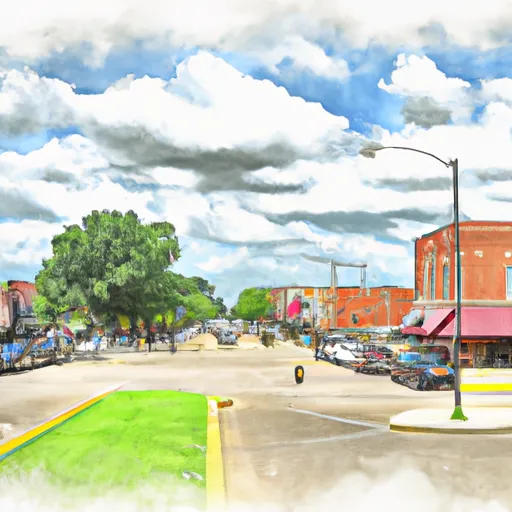-
 Snoflo Premium
Snoflo Premium
Get unlimited access to all our content
With no Ad interruptions! - Start Your Free Trial Login with existing account
Belleville
Eden Index
Climate
8.0
•
Recreation
5.7
•
Community
0.8
•
Safeguard
5.4/10

Belleville, Arkansas is a small town located in the Ozark Mountains. The climate is temperate with hot summers and mild winters. The area receives an average of 46 inches of rainfall per year, which contributes to the area's hydrology. The nearby Buffalo River and Kings River provide opportunities for fishing, kayaking, and canoeing. Hiking is also a popular activity in the surrounding Ozark National Forest, with trails such as the Ozark Highlands Trail and the Buffalo River Trail offering scenic views of the area's natural beauty. Belleville is a great destination for those looking to enjoy the outdoors and experience the beauty of the Ozarks.
What is the Eden Index?
The Snoflo Eden Index serves as a comprehensive rating system for regions, evaluating their desirability through a holistic assessment of climate health, outdoor recreation opportunities, and natural disaster risk, acknowledging the profound impact of these factors on livability and well-being.
Climate Health Indicator (CHI): 8.0
Belleville receives approximately
1241mm of rain per year,
with humidity levels near 89%
and air temperatures averaging around
16°C.
Belleville has a plant hardyness factor of
7, meaning
plants and agriculture in this region tend to thrive during the non-winter months.
By considering the ideal temperature range, reliable water supplies, clean air, and stable seasonal rain or snowpacks, the Climate Health Indicator (CHI) underscores the significance of a healthy climate as the foundation for quality living.
A healthy climate is paramount for ensuring a high quality of life and livability in a region, fostering both physical well-being and environmental harmony. This can be characterized by ideal temperatures, reliable access to water supplies, clean air, and consistent seasonal rain or snowpacks.
Weather Forecast
Streamflow Conditions
Lower Arkansas-Fourche La Fave
Area Rivers
Lower Arkansas-Fourche La Fave
Snowpack Depths
Lower Arkansas-Fourche La Fave
Reservoir Storage Capacity
Lower Arkansas-Fourche La Fave
Groundwater Levels
Recreational Opportunity Index (ROI): 5.7
The Recreational Opportunity Index (ROI) recognizes the value of outdoor recreational options, such as parks, hiking trails, camping sites, and fishing spots, while acknowledging that climate plays a pivotal role in ensuring the comfort and consistency of these experiences.
Access to outdoor recreational opportunities, encompassing activities such as parks, hiking, camping, and fishing, is crucial for overall well-being, and the climate plays a pivotal role in enabling and enhancing these experiences, ensuring that individuals can engage in nature-based activities comfortably and consistently.
Camping Areas
| Campground | Campsites | Reservations | Toilets | Showers | Elevation |
|---|---|---|---|---|---|
| Ivan Lake | 4 | 212 ft | |||
| Highway 157 Primitive | None | 203 ft | |||
| Harmon Lake Dam - Barksdale AFB | 6 | 222 ft | |||
| Teague Lake Primitive | None | 199 ft | |||
| Turtle Slide | None | 223 ft | |||
| Fair City RV Park | 100 | 317 ft | |||
| Frank Anthony RV Park | 30 | 242 ft | |||
| Barksdale AFB Military | None | 160 ft | |||
| Lake Bistineau State Park | None | 170 ft | |||
| South Abutment East | 12 | 177 ft |
Nearby Ski Areas
Catastrophe Safeguard Index (CSI):
The Catastrophe Safeguard Index (CSI) recognizes that natural disaster risk, encompassing floods, fires, hurricanes, and tornadoes, can drastically affect safety and the overall appeal of an area.
The level of natural disaster risk in a region significantly affects safety and the overall livability, with climate change amplifying these risks by potentially increasing the frequency and intensity of events like floods, fires, hurricanes, and tornadoes, thereby posing substantial challenges to community resilience and well-being.
Community Resilience Indicator (CRI): 0.8
The Community Resilience Indicator (CRI) recognizes that education, healthcare, and socioeconomics are crucial to the well-being of a region. The CRI acknowledges the profound impact of these elements on residents' overall quality of life. By evaluating educational resources, healthcare accessibility, and economic inclusivity, the index captures the essential aspects that contribute to a thriving community, fostering resident satisfaction, equity, and social cohesion.

